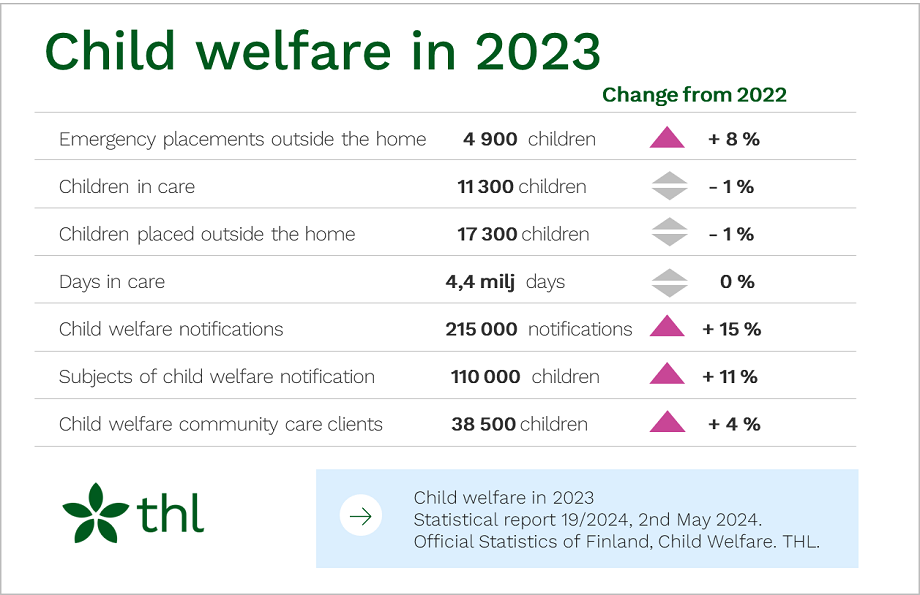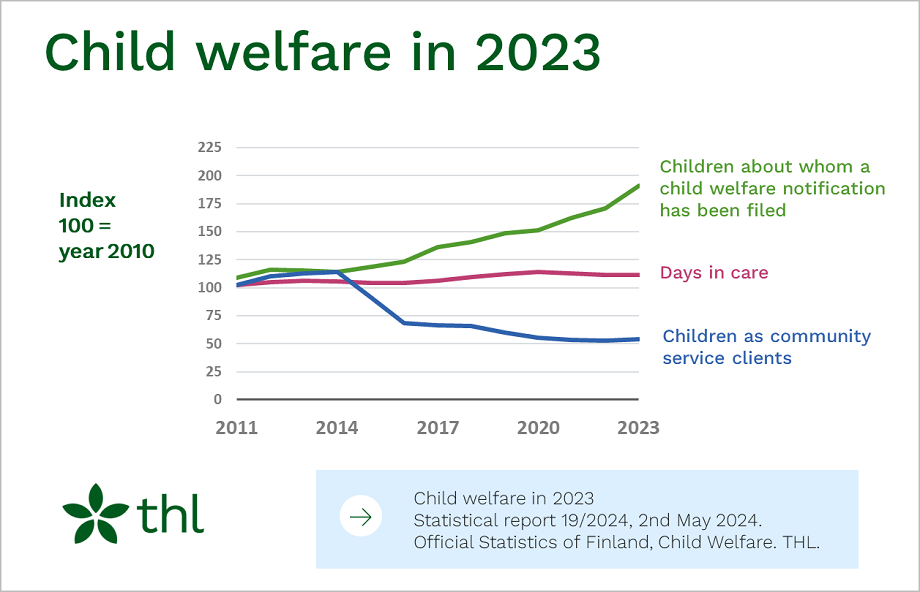Child welfare notifications filed for one out of six children aged 13 to 15 in 2023, numbers keep increasing
The Finnish Institute for Health and Welfare’s latest statistics show that a child welfare notification was filed for one out of six children aged between 13 and 15 in 2023. While the number of these notifications has increased annually, the growth was exceptionally large in 2023.
In 2023, almost 31,000 child welfare notifications were filed for children aged 13 to 15, whereas three years earlier, this figure for the same age group was 21,000. Children aged between 13 to 15 years continue to be the very age group for which the highest number of child welfare notifications is filed. Their number has also increased the most in this age group.
"Measured by different indicators, young people have been struggling more in recent years. It would be surprising if, for example, young people's increasing mental health problems and the pressure on mental health and substance abuse services were not reflected in the need for child welfare services," says Taina Laajasalo, Research Professor at THL.

Child welfare notifications doubled in ten years
The number of child welfare notifications went up in all wellbeing services counties in 2023. Nationally, this number has more than doubled over ten years. In 2023, a notification was filed for 110,000 children, or 10.2%.
While many authorities, including the police and day-care centres, have an obligation to make child welfare notifications, they can be filed by anyone. Child welfare notifications are indeed filed in large range of situations.
"Child welfare notifications are often indicative of young people's symptoms. On the other hand, a notification may be made in a situation where the mother of a young child is about to start substance abuse treatment and her child needs a place of care. Every notification must be taken seriously," says Laura Yliruka, Development Manager at THL.
"At the same time, we can challenge professionals to discuss the rules of filing these notifications. For example, situations where the school's educational interventions are sufficient and where calling in the child welfare services is justified should be determined. A balance can be found through dialogue, freeing up resources used to process notifications for work with children and families who need protection and support", Yliruka reflects.
Emergency placement numbers went up
The number of emergency placements went up by 7% in 2023, with a particular increase in first placements of children's lives. They may involve either a placement made as community care support measure or taking the child into care.
The highest number of emergency placements are made for 15-year-olds. One per cent of children aged 15 were in an emergency placement during the year.
The proportion of children in emergency placements was the highest in Kymenlaakso (1.7%) and the lowest in South Karelia (0.4%). Emergency placement numbers grew in several regions in 2023, however not everywhere. The greatest reduction in emergency placements was registered in Satakunta.
"In some areas, emergency placements are only resorted to in acutely dangerous situations, whereas elsewhere they are also used as planned interventions, for example to intervene in a child's substance abuse. The increase in the number of emergency placements has a number of underlying factors. They include situations coming to a crisis point in family social work because child welfare services cannot be accessed in time", Yliruka says.
Number of community care clients also started to grow
The number of children and young people who were clients of child welfare community care increased in 2023. The last time an increase in client numbers was recorded was in 2014.
"This may indicate that family social work services and other basic services that precede community care in child welfare do not fulfil their preventive function optimally, and multidisciplinary cooperation does not work appropriately," says Laura Yliruka.
"Some families seek support from child welfare themselves, while others in need of these services do not have the resources or trust needed to accept family social work or child welfare services. By emphasising cooperation between families and child welfare, we can build trust, enabling us to channel help to families better", Yliruka explains.
No significant changes in the number of placed children
The number of children taken into care remained at the previous years' level in 2023. The number of days in placement has also remained stable for a long time.

Source
Additional information
Martta Forsell
Development Manager
tel. +358 29 524 7974
[email protected]
Laura Yliruka
Development Manager
tel. +358 29 524 7982
[email protected]
Taina Laajasalo
Research Professor
tel. +358 29 524 7982
[email protected]



